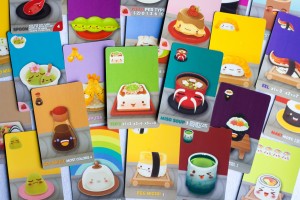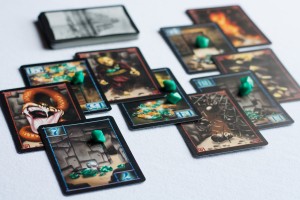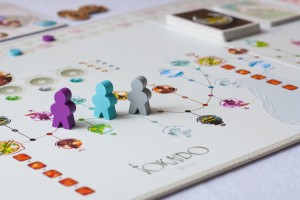Family Game Night: What the Kids Are Playing These Days
It’s time for what’s turning out to be an annual tradition here on the blog: new family board game recommendations, just in time for the holidays. See below for a few games the girls and I have enjoyed playing this year. See also my earlier posts for recommended favorites like Splendor, Tsuro, and Dominion, or Ghost Blitz, Mysterium, and Mice & Mystics, or Sleeping Queens, Love Letter, and Forbidden Island.
Sushi Go Party! (Gamewright, 2016) –  Last year, I recommended Sushi Go!, noting that its smiling sushi and solid game mechanics made it a fast favorite in our family. This year, Gamewright came out with an expanded edition of the game called Sushi Go Party! I picked it up very recently, but have already gotten in a few plays. The girls love it. It’s just as cute and fun as the original, but adds a lot of options for new ways to play.
Last year, I recommended Sushi Go!, noting that its smiling sushi and solid game mechanics made it a fast favorite in our family. This year, Gamewright came out with an expanded edition of the game called Sushi Go Party! I picked it up very recently, but have already gotten in a few plays. The girls love it. It’s just as cute and fun as the original, but adds a lot of options for new ways to play.
The core mechanics are the same as in the original: On each turn, each player picks one card from their hand to keep, then passes the rest of the cards to the left. Then each player picks a card from their new hand, and passes the rest to the left. Repeat until all the cards in all the hands have been claimed. At the end of the round, you score the cards you’ve kept according to various rules that depend on card type. For instance, if you have one Tempura card, it’s worth no points, but if you have a pair, they’re worth 5 points. If you have more Maki cards than anyone else, you get 6 points. Secondmost Maki cards will earn you 3 points. Eel is an acquired taste: If you have one Eel, you lose 3 points, but if you have two Eels, you gain 7 points. And so on. You play three rounds like this, then score any dessert cards you picked up along the way. Highest score wins!
The new game includes the original game (so there’s no need to get both), but it comes with many more card types. Each time you play, you select seven card types to shuffle into the deck, which adds a lot of replay value to the game. The instructions include several suggested “menus,” including the classic menu from the from original game, the Party Sampler (featuring mostly new card types), the Points Platter (with cards that can rack up lots of points), and the Cutthroat Combo (with cards that involve player interaction). You can also create your own “menu,” following a few parameters spelled out in the instructions.
Even better, Sushi Go Party! can handle up to 8 players. (Thus the “Party!” in the title.) The original topped out at five players. Going into Thanksgiving, I knew the game worked well at 2 and 3 players. On Thanksgiving, with lots of family around, I got to play with 8 players, and the game scaled up well. (Just remember to put more dessert cards in the deck with higher player counts!)
As with the original, Sushi Go Party! is quick to learn, although figuring out all the new card types (and ways to play them well) will take some time. Our games took closer to half an hour, but I expect that once we get the hang of the new card types, we’ll be able to play in 15-20 minutes. Given the memory work and planning that it takes to do well, I would recommend Sushi Go Party! for ages 8 and up, which is just what the colorful tin box says, too.
One more bit of info: The new game comes with a little board that serves as a reminder of what card types are in play and provides a scoring track. No more pencil and paper scoring!
Incan Gold (Eagle-Gryphon Games, 2006) –  Here’s another game that can handle 8 players, although I’ve only played with 3. Incan Gold is a press-your-luck game in which players explore the ruins of an ancient Incan temple looking for treasure. Each round, each player decides secretly to keep exploring or head back to camp. Players reveal their choices simultaneously, then the top card on the “Quest” deck is flipped over and added to the play area. If it’s a treasure card, the players still exploring split the treasure listed on the card. If it’s a hazard card, and if it’s the second of the same type of hazard (poisonous snake, giant spiders, fire traps, crazy Incan mummy), then all the players still exploring lose the round, as well as any treasure they’ve picked up.
Here’s another game that can handle 8 players, although I’ve only played with 3. Incan Gold is a press-your-luck game in which players explore the ruins of an ancient Incan temple looking for treasure. Each round, each player decides secretly to keep exploring or head back to camp. Players reveal their choices simultaneously, then the top card on the “Quest” deck is flipped over and added to the play area. If it’s a treasure card, the players still exploring split the treasure listed on the card. If it’s a hazard card, and if it’s the second of the same type of hazard (poisonous snake, giant spiders, fire traps, crazy Incan mummy), then all the players still exploring lose the round, as well as any treasure they’ve picked up.
The goal is to amass the most treasure. Head back to camp early, and you’ll almost surely keep what treasure you’ve found, but you won’t find much. Press your luck and keep exploring, and you’ll find lots of treasure (and keep a greater share of it as other players bail), but you might lose everything if you draw the wrong hazard. The game can get a little stressful! But it’s played over five rounds, so even if you have a bad round, you get a chance to redeem yourself.
Incan Gold is a light, fun family game that plays in 20 or 30 minutes. There’s a bit more to it than what I’ve described (some special treasures that add a bit of complexity), but it’s a pretty simple game. The press-your-luck mechanic gives it a lot of energy. It’s not technically a storytelling game, but when we play, we like to name our explorers (“Tennessee Smith,” “Norway Svenson,” “Jeff”) and narrate our exploration as we flip over Quest cards.
The game box says ages 8 and up, but you could play with younger kids if you think they can handle a dramatic loss every now and then. I haven’t tried it with more than 3 players, but I think it would make for a fun party game, given the press-your-luck element and all the shiny treasure pieces.
Tokaido (Funforge, 2012) –  I can’t believe I haven’t already recommended Tokaido here on the blog. It’s been a favorite of ours for a while now. I like to describe Tokaido as “competitive vacationing.” Players take on the roles of travelers in 17th century Japan making their way along Tokaido, the road that connected Kyoto to Edo. As you travel, you earn points by doing relaxing or interesting or noble things, like painting landscapes, visiting hot springs (and maybe spotting snow monkeys), shopping for souvenirs, donating at the temple, meeting fascinating fellow travelers, or enjoying good meals. The game is beautiful, with a long, elegant board and charming artwork throughout. It’s one of the most attractive games in my collection.
I can’t believe I haven’t already recommended Tokaido here on the blog. It’s been a favorite of ours for a while now. I like to describe Tokaido as “competitive vacationing.” Players take on the roles of travelers in 17th century Japan making their way along Tokaido, the road that connected Kyoto to Edo. As you travel, you earn points by doing relaxing or interesting or noble things, like painting landscapes, visiting hot springs (and maybe spotting snow monkeys), shopping for souvenirs, donating at the temple, meeting fascinating fellow travelers, or enjoying good meals. The game is beautiful, with a long, elegant board and charming artwork throughout. It’s one of the most attractive games in my collection.
As pretty as Tokaido is, what really drives the game is the movement mechanic. Everyone is on the same road, and it’s the player at the back of the pack that moves next. When moving, you can travel anywhere ahead on the road (until the next inn, where everyone has to stop to stay the night), but if you move too far ahead (say, to the next painting spot to complete your painting) you won’t get as many turns (since it’s the player at the back that moves next) and you’ll miss opportunities to earn points along the way. In that respect, the game feels like actual vacationing, since I find I’m always making tough choices about how to spend our time on the road!
Since all the players are on the same road, jockeying for the same spots, Tokaido can get pretty competitive. For instance, there aren’t many ways to earn coins in the game (which you’ll need at the inn, at the souvenir shops, and at the temple). If you know a fellow player is running short on money, you might grab the “work in the fields” spot that earns three coins, just to keep them from going there.
Another example: Everyone has to stop at the four inns along the road. The first player to get to an inn gets first choice of the available dinners, which are each worth six points but cost different amounts of money. Getting there first can guarantee you get to eat (and earn those six points), but it also means you’re last to leave the inn the next day, which means you’ll have fewer choices for your first move. The game is full of tough choices like these.
Tokaido can handle between 2 and 5 players. It plays well at all player counts, including 2-player, which involves a third “dummy” player that the two players take turns controlling to block each other. (We always use the gray piece for this, and we call our dummy player “Mr. Gray.”) The box says “ages 8+”, and that sounds about right for competitive players. Younger players could still enjoy the game with a bit of help. It’s a medium-length game: expect Tokaido to take close to an hour.
Istanbul (AEG, 2014) –  I first played this at Tennessee Game Days, a local board game convention, back in 2015. I really enjoyed it, but kept waiting for a sale to buy it. Then, this fall, a very perceptive friend gave it to me as a gift. I tried it out with the girls, and they liked our first game so much that they asked to play a second game right away!
I first played this at Tennessee Game Days, a local board game convention, back in 2015. I really enjoyed it, but kept waiting for a sale to buy it. Then, this fall, a very perceptive friend gave it to me as a gift. I tried it out with the girls, and they liked our first game so much that they asked to play a second game right away!
In Istanbul (not Constantinople), players take on the role of merchants, working their way around the markets, gathering goods and selling them for income. The goal is to be the first player to get five rubies, which can be obtained in several ways, including selling the right combination of goods or spending enough cash. Purchasing rubies gets increasingly expensive as the game goes on, so there’s a race to get the resources you need for your rubies. Fortunately, all sixteen spaces on the board give you something when you land on them, so there are lots of options for generating resources. This also makes the game fun for younger players, since they’ll always get something useful no matter which move they make.
Like Tokaido, Istanbul has an interesting movement mechanic. Your merchant token starts with four assistant tokens underneath it. (The game calls them assistants, my family calls them interns, because we listen to Night Vale.) Every time you move, you leave an assistant token at the place you land. When you’re out of assistant tokens, you either have to move back to a place you’ve been to pick up an assistant, or head back to the Fountain, where you can summon all your assistants back to you. (We insist that each player have a particular summon they use at this moment. Hannah goes with a turkey call, Lily likes to whistle, and I yell out “Hey you guys!” like on Electric Company.) The movement mechanic means you have to plan your moves fairly carefully, and it rewards a certain kind of efficiency of movement.
Also like Tokaido, Istanbul is an attractive game, with colorful artwork and interesting components. The shiny red rubies are just the best. It has a fair amount of replay value, since the sixteen market locations can be shuffled each time you play to create a different set of movement options. Istanbul can handle between 2 and 5 players. At the higher player counts, the board gets crowded more easily, which makes for harder decisions. The game probably plays best at 4, since that keeps the crowding effect, but also plays pretty quickly.
The box says “ages 10+”, but my eight-year-old had no problem playing. She’s kind of an exceptional board game players, but I think most eight-year-olds would be fine with Istanbul, since there aren’t too many choices to make at any given time and, as I noted, every place you land gives you something useful. The only problem we had was that Lily likes to plan out a bunch of moves ahead, and when Hannah blocked one of those moves (by taking a space Lily had planed to go), Lily got pretty frustrated. So that’s something to watch out for.
Monarch (Resonym, 2015) –  This is yet another beautiful game, with attractive, moody art. In Monarch, players take on the role of princesses proving they have what it takes to be the next queen. In contrast to some depictions of princesses, the princesses in Monarch have multiple routes to the throne, and none of them involve falling in love with a prince.
This is yet another beautiful game, with attractive, moody art. In Monarch, players take on the role of princesses proving they have what it takes to be the next queen. In contrast to some depictions of princesses, the princesses in Monarch have multiple routes to the throne, and none of them involve falling in love with a prince.
First, you feed and tax your people to generate income, then you spend your resources to build your court, by buying various cards from a shared market. The cards come in four suits — bounty, wisdom, culture, and might — and each is worth some number of points. You can specialize in a single suit by choosing the banner for that suit, which allows you to earn more points at the end of the game based on the cards you collect from that suit. The cards themselves are fun to look at and very thematic: a Cornucopia in the bounty suit, Harpists and Floutists in the culture suit, a Massive Encyclopedia in the wisdom suit, or a Radiant Dragon in the might suit. Each suit also has a couple of outfits, for those with traditional princess interests, although even the outfits are thematic, such as Meditation Robes (wisdom) or Gold and Silver Armor (might).
Occasionally during the game, you’ll draw a moon card, which might have a beneficial effect for one or all players, or might ask the players to collectively sacrifice some resources to avoid some negative effect. These cards can take some negotiation, although they’re not usually too hard to handle. A more important mechanic is the ability on your turn to spend a few coins to “sweep the market,” replacing the five cards currently available for purchase with five new ones. You might use this ability to search for cards that match your banner suit, or you could use it defensively to prevent other players from getting cards they want. Also, some of the cards you buy are worth negative points. They don’t go in your court, however; you send these unwanted guests (like a Boorish Uncle or Useless Emissary) to your opponents’ courts.
Monarch packs some clever mechanics into a fun game, one that, like Tokaido, presents a different theme than you usually see in board games. It plays in about an hour, for 2 to 4 players. It’s rated 12 and up, but I think most 10-year-olds would have fun with it. I’ve only played it once with adults, but it was fun, as well as a bit more cutthroat than it was with my girls.
There you have it, my family board game recommendations for the 2016 holiday season. What games would you recommend?